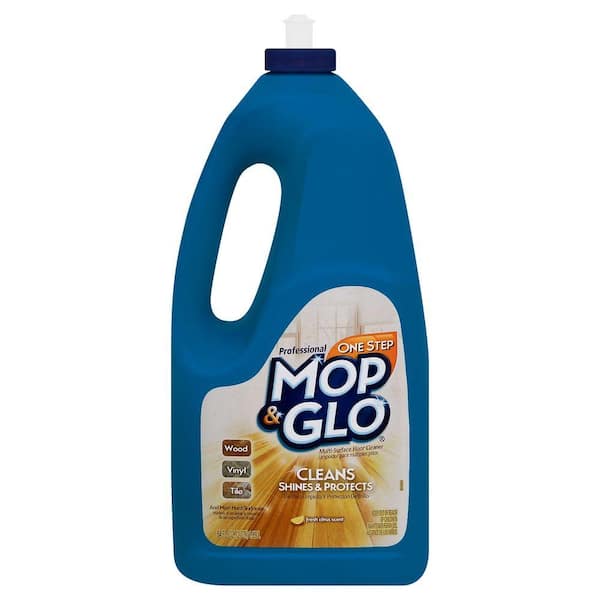Picture this: You’ve just finished a big family gathering. The delicious aromas of your cooking still linger in the air, but you’re left with a sticky film on your laminate floors, a haunting reminder of the fun you’ve just had. You reach for the trusty bottle of Mop & Glo, thinking it’ll be a quick fix. But hold on! Is using Mop & Glo on your laminate floors a wise decision, or are you about to make a mistake that could leave your beautiful floors looking dull and damaged?

Image: mopreviewed.com
This is a question that many homeowners grapple with. Laminate floors are a popular choice for their durability and affordability, but they require careful maintenance to maintain their shine and longevity. The good news is, you don’t have to be a flooring expert to understand whether or not Mop & Glo is the right choice for your laminate floors. This article will delve into the world of laminate floor care, explaining the pros and cons of using Mop & Glo, and offering you alternative methods to keep your floors sparkling clean.
The Science Behind Laminate Floors
To truly understand whether or not Mop & Glo is appropriate for your laminate floors, we need to grasp the science behind their construction. Laminate flooring isn’t solid wood; it’s engineered by layering different materials. The top layer is a photographic image of wood, stone, or another design, printed on a thin sheet of melamine resin. This layer is then bonded to a core layer, usually composed of high-density fiberboard (HDF) or medium-density fiberboard (MDF). The core provides strength and stability, and a final layer of wear-resistant melamine resin protects the entire surface.
These layers are designed to mimic the look and feel of natural materials, but they behave differently when it comes to cleaning. The melamine resin is remarkably resistant to scratches and stains, but it can be sensitive to the wrong cleaning products.
Mop & Glo: A Closer Look
Mop & Glo, for those unfamiliar, is a popular floor cleaning solution that promises to leave floors shiny and protected. It typically contains a combination of cleaning agents, polishes, and waxes. While its ability to create a dazzling shine on certain surfaces is undeniable, its impact on laminate floors can be quite different.
The Potential Problems
Mop & Glo’s primary ingredient is often a type of acrylic polymer, which creates a thin film over the surface of the floor. While this film can provide a temporary shine, it can also trap dirt, dust, and grime, leading to a dull, cloudy appearance over time. Additionally, the waxes and polishes in Mop & Glo can build up on laminate floors, making them slippery and potentially dangerous, especially for young children and elderly individuals.
Another crucial point to remember is that laminate flooring is not designed to be waxed. Waxes can interfere with the floor’s protective coating, leading to premature wear and tear. Mop & Glo, with its wax-based formula, can create a buildup on laminate floors that ultimately hinders their natural resistance to scratches and stains.

Image: mromavolley.com
Alternatives for Laminate Floor Care
Now that we’ve explored the potential downsides of using Mop & Glo on laminate floors, it’s time to discover safer and more effective cleaning solutions.
-
Water-Based Cleaners: The simplest and safest option for cleaning laminate floors is often to use a damp mop and plain water. For a deeper clean, you can add a small amount of mild dish soap to a bucket of warm water. Look for soaps that are specifically designed for cleaning floors and are free from fragrances and harsh chemicals. Gentle cleaning is essential to avoid stripping the protective layer of the laminate.
-
Laminate Floor Cleaning Products: There are specialized laminate floor cleaners available in the market that are formulated specifically to clean and maintain these surfaces. These cleaners are typically pH-neutral and free from waxes, oils, and harsh chemicals, ensuring they don’t damage the floor’s protective coating.
-
Microfiber Mops: Microfiber mops are a great choice for cleaning laminate floors as they are highly absorbent and effective at picking up dust and dirt. They leave the floor dry, minimizing the risk of streaks and spots.
Cleaning Tips for Laminate Floors:
-
Always sweep or vacuum your laminate floors before mopping. This removes loose dirt and debris that could scratch the surface.
-
Use a damp, not soaking wet mop. Too much water can seep under the seams of the laminate, causing warping or damage.
-
Never use abrasive cleaners on your laminate floors. These can scratch the surface and dull the finish.
-
Dry the floors thoroughly after mopping. This prevents watermarks and streaking.
-
Avoid using abrasive cleaning tools like steel wool or scouring pads. These can leave behind scratches.
Can You Use Mop N Glo On Laminate Floors
The Verdict: What’s Best for Your Floors?
While Mop & Glo may make your laminate floors look shiny, it’s important to remember that this shine comes at a price. The buildup of wax and polish can lead to dullness, uneven surfaces, and even pose safety hazards. For long-term care and protection, it’s always best to stick with gentle, specialized laminate floor cleaners and avoid products that are formulated for other floor types.
Investing in a reliable mop and using simple, effective cleaning solutions will protect your investment in your laminate floors for years to come. Remember, a little effort now can go a long way in keeping your floors looking beautiful and durable.






